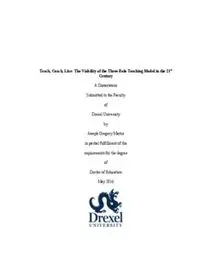
Teach, Coach, Live PDF
Preview Teach, Coach, Live
st Teach, Coach, Live: The Viability of the Three-Role Teaching Model in the 21 Century A Dissertation Submitted to the Faculty of Drexel University by Joseph Gregory Martin in partial fulfillment of the requirements for the degree of Doctor of Education May 2016 © Copyright 2016 Joseph Gregory Martin. All Rights Reserved This Ed.D. Dissertation Committee from The School of Education at Drexel University certifies that this is the approved version of the following dissertation: st Teach, Coach, Live: The Viability of the Three-Role Teaching Model in the 21 Century Joseph Gregory Martin Committee: ____________________________________ Allen C. Grant, Ph.D. ____________________________________ John Gould, Ph.D. ____________________________________ Seth Boyd, Ph.D. ____________________________________ Date Dedication I dedicate this dissertation to my wife Glynis for her constant support throughout my work on this endeavor. Your love, enthusiasm, patience, reassurance, and support made this work possible. I also dedicate this dissertation to my late father, the Rev. Dr. Wesley Martin. Even though he was unable to be part of my doctoral work, his influence and belief in academia was a constant presence. iv Acknowledgments I would like to thank Dr. Allen Grant, my dissertation chair for his ongoing support and interest in this study, as well as committee member Dr. John Gould, for his input and thoughtful suggestions. In addition, Dr. Seth Boyd offered a wonderful sounding board and editor in this process. His “in the trenches” view as a current triple- threat educator was invaluable and conversation during long bike rides provided food for thought. I would like to thank Peter Gow of the Independent Curriculum Group, and a longtime triple-threat educator, for his constant ideas and support. In addition, many thanks to Dr. Kevin Hicks, Dr. John Chubb, Dr. Jerry Larson, Dr. Richard Phelps, Mr. Simon Holzapfel, Ms. Trudy Hall, Dr. Anthony Sgro, Mr. Phil Peck, Mr. Peter Becker, Mr. Chris Fleischner, Mr. Charlie Cahn, Dr. Peter Cookson, and Ms. Jane Armstrong. Each of these people, as heads of school, consultants, authors, and all-around school people, provided insight and guidance at every turn. From answering emails to dedicating time from their busy schedules, the spirit of this study was supported by them. v Table of Contents LIST OF TABLES ........................................................................................................... viii LIST OF FIGURES ........................................................................................................... ix 1. INTRODUCTION TO THE RESEARCH ....................................................................1 Introduction to the Problem ..........................................................................................1 Statement of the Problem to Be Researched ................................................................12 Purpose and Significance of the Problem ....................................................................12 Research Questions ......................................................................................................13 Conceptual Framework ................................................................................................14 Definition of Terms ......................................................................................................18 Assumptions and Limitations ......................................................................................19 Summary ......................................................................................................................20 2. LITERATURE REVIEW ............................................................................................21 Introduction to Chapter 2 .............................................................................................21 Literature Review .........................................................................................................23 Conclusion ...................................................................................................................39 3. RESEARCH METHODOLOGY.................................................................................41 Introduction ..................................................................................................................41 Research Design and Rationale ...................................................................................43 Site and Population ......................................................................................................45 Research Methods ........................................................................................................48 vi Ethical Considerations .................................................................................................56 Summary ......................................................................................................................57 4. FINDINGS AND RESULTS .......................................................................................58 Findings .......................................................................................................................60 Results and Interpretations ...........................................................................................95 Summary ......................................................................................................................96 5. CONCLUSIONS AND RECOMMENDATIONS ......................................................97 Introduction ..................................................................................................................97 Conclusions ..................................................................................................................98 Recommendations ......................................................................................................106 Recommendations for Future Research .....................................................................111 Summary ....................................................................................................................112 LIST OF REFERENCES .................................................................................................114 APPENDIX: SURVEY INSTRUMENT .........................................................................119 vii List of Tables 1. Triple Threat Roles .....................................................................................................6 2. Elite Boarding Schools .............................................................................................47 3. Methods of Collection and Analysis .........................................................................49 4. Qualitative Subjects ..................................................................................................60 5. Use of the Triple Threat Model ................................................................................61 6. Directional Measure: Model Use and Pressure .........................................................63 7. Triple Threat Under Pressure with Regard to Sustainability ....................................63 8. Sustainability of the Triple-Threat Model ................................................................64 9. Continued Use of the Triple-Threat Model ..............................................................64 10. FLSA Changes in the Triple Threat ..........................................................................65 11. Parental Pressure for Experts in Academic Subjects ................................................66 12. Parental Pressure for Expert Coaches .......................................................................68 13. Parental Pressure for a Focused Residential Life Curriculum ..................................69 14. Changes in Work/Life Balance .................................................................................70 15. School Location and Pressure on the Triple Threat ..................................................71 16. Size of School and Pressure on the Triple-Threat Model .........................................72 17. Endowment Dollars Per Student and Belief the Triple Threat is Sustainable ..........72 18. Use of the Triple-Threat Model and Sustainability ..................................................73 19. Interview Themes ......................................................................................................75 viii List of Figures 1. Conceptual framework ..............................................................................................17 2. Stages of data collection ...........................................................................................55 3. Impacts on the triple threat .....................................................................................109 ix Abstract st Teach, Coach, Live: The Viability of the Three-Role Teaching Model in the 21 Century Joseph Gregory Martin, Ed.D. Drexel University, May 2016 Chairperson: Allen C. Grant This explanatory mixed-methods study is focused on the sustainability of the triple-threat model of teaching found at elite American boarding schools. In this model, faculty members are expected to teach, coach, and perform residential duties as part of their contract. While elite boarding schools have been researched in recent years, no research exists on the teachers at these institutions or the hiring model used to staff them. In recent years, a great deal of discussion has come to the fore within elite boarding schools concerning the future of the triple-threat model. With cultural and economic changes impacting elite boarding schools, the long-standing staffing model is being pressured from both internal and external forces. These pressures bring the future of the triple-threat model into question. Viewed through a grounded theory approach, the researcher is using collected data to determine if the triple-threat is indeed under pressure and if so, whether this model is sustainable given these pressures. Surveys given to heads of 28 schools identified as elite were combined with interviews with heads of these schools to construct a review of the triple-threat model and its place in these elite schools in the years to come. Results of this study can be applied to hiring practices in both elite and non-elite schools to create a staffing model that is both good for the students and sustainable for the school. x
